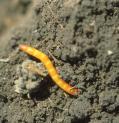|
Insect pests
aren't as plentiful during the early growing season as they are in
midsummer, but that doesn't mean your garden crops are pest free.
Slugs, cutworms, wireworms, grubs, maggots and flea beetles are among the
pests that can plague the early garden.
 Slugs, those slimy, soft-bodied snails-without-shells,
hide in cool, moist places during the day and come out on warm evenings to
feed on plant leaves.
Mulching around plants may increase slug problems by
creating a handy hiding place. If you mulch and have a chronic slug problem,
you should be mulching and watering conservatively and placing
boards, cardboard or newspapers on the soil between the rows in vegetable
gardens. The slugs
will seek out these hiding places. During the day, lift the shelter
materials and "harvest" slugs by scraping them into a container of soapy water. Slugs, those slimy, soft-bodied snails-without-shells,
hide in cool, moist places during the day and come out on warm evenings to
feed on plant leaves.
Mulching around plants may increase slug problems by
creating a handy hiding place. If you mulch and have a chronic slug problem,
you should be mulching and watering conservatively and placing
boards, cardboard or newspapers on the soil between the rows in vegetable
gardens. The slugs
will seek out these hiding places. During the day, lift the shelter
materials and "harvest" slugs by scraping them into a container of soapy water.
 Cutworms are plump, hairless
caterpillars that emerge
from the soil at night to feed on newly emerged seedlings and newly set
transplants. Though they seem to have a special preference for pepper
plants, they will attack most garden crops. They are called "cutworms" because they frequently snip plants off at or just below
the soil surface. Cutworms are plump, hairless
caterpillars that emerge
from the soil at night to feed on newly emerged seedlings and newly set
transplants. Though they seem to have a special preference for pepper
plants, they will attack most garden crops. They are called "cutworms" because they frequently snip plants off at or just below
the soil surface.
An effective non-chemical control is cutworm collars,
rings of light cardboard placed around small plants. The larger sized
juice concentrate cans with the metal ends removed can be sliced crosswise
to make two or three cutworm collars.
 Wireworms are slender, dark-colored beetle larvae; white
grubs are plump, whitish and C-shaped beetle larvae. Both attack plant
roots, especially in areas recently converted to garden from lawn or
fallow field. If tilling turns up large numbers of either of these pests, treating the soil with a soil insecticide or working it for
a year before planting may be necessary to avoid extensive crop damage. Wireworms are slender, dark-colored beetle larvae; white
grubs are plump, whitish and C-shaped beetle larvae. Both attack plant
roots, especially in areas recently converted to garden from lawn or
fallow field. If tilling turns up large numbers of either of these pests, treating the soil with a soil insecticide or working it for
a year before planting may be necessary to avoid extensive crop damage.
Cabbage-family crops, sweet corn and
onions are all
susceptible to damage by maggots. These are the larvae of several species
of flies that lay their eggs on these crops. The larvae's feeding on the
roots kills the plant or damages the roots so severely that plant growth
is stunted. Cabbage maggots attack all the Cole
crops, including broccoli, Brussels sprouts, cabbage and radishes. Seed
corn maggots attack the germinating seeds of sweet corn,
cucumbers, melons
and squash. Onion maggots feed on members of the onion family. feeding on the
roots kills the plant or damages the roots so severely that plant growth
is stunted. Cabbage maggots attack all the Cole
crops, including broccoli, Brussels sprouts, cabbage and radishes. Seed
corn maggots attack the germinating seeds of sweet corn,
cucumbers, melons
and squash. Onion maggots feed on members of the onion family.
 Flea beetles are very small, usually black beetles that
chew tiny round holes in the leaves of tomato, pepper and eggplant
transplants and in new potato sprouts and radish and turnip foliage. The
larvae feed on plant roots. Feeding by large numbers of beetles gives
leaves a shot-hole appearance and slows plant
growth. Flea beetles are very small, usually black beetles that
chew tiny round holes in the leaves of tomato, pepper and eggplant
transplants and in new potato sprouts and radish and turnip foliage. The
larvae feed on plant roots. Feeding by large numbers of beetles gives
leaves a shot-hole appearance and slows plant
growth.
|



